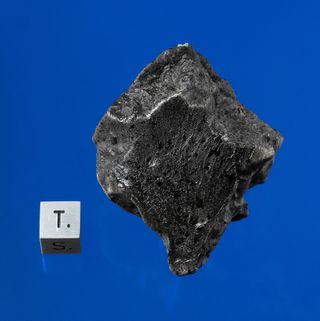Mystery of Martian Meteorites' Organic Stuff Solved

Organic molecules — compounds that on Earth can be linked with life — encased within Martian meteorites now reveal biological activity on the Red Planet could not have formed these materials, researchers say.
Organic molecules are the carbon-based raw materials that building blocks of life such as proteins and DNA are made from. These organic compounds have been detected in meteorites from Mars that crashed on Earth before, but scientists have hotly debated what their origins are — they might be signs of life on the Red Planet, or merely contaminants that made their way into the rocks after they landed.
To help solve the mystery behind these organic molecules, researchers analyzed 11 Martian meteorites, including the new Tissint meteorite that fell into the Moroccan desert in 2011. Altogether, these rocks span 4.2 billion years of Martian history.
The investigators now reveal that organic molecules within these meteorites did originate on Mars.
"Mars apparently has had organic carbon chemistry for a long time," study lead author Andrew Steele, a microbiologist at the Carnegie Institution of Washington, told SPACE.com.
However, these organic molecules do not appear biological in origin.
"They formed from volcanic processes," Steele said.
Get the Space.com Newsletter
Breaking space news, the latest updates on rocket launches, skywatching events and more!
Ten of the meteorites possessed complex hydrocarbons — compounds of carbon and hydrogen atoms — encased within grains of crystallized minerals that formed within cooling magma. [5 Bold Claims of Alien Life]
"When the minerals crystallized from the magma, they trapped carbon in them, and over time, organic compounds formed within these mineral bottles," Steele said.

An open question now is what other activity might have taken place on Mars after such organic molecules formed.
"We now find that Mars has organic chemistry, and on Earth, organic chemistry led to life, so what is the fate of this material on Mars, the raw material that the building blocks of life are put together from?" Steele said.
Now that scientists have a better picture of the foundations of Martian chemistry, they can better look for anomalies that might be signs of life with missions to the Red Planet, such as NASA's Mars Science Laboratory, scheduled to land the Curiosity rover on Mars in August this year.
"We'll see if there are hints that Mars is not a dead planet," Steele said.
The scientists detailed their findings online today (May 24) in the journal Science.
Follow SPACE.com for the latest in space science and exploration news on Twitter @Spacedotcom and on Facebook.
Join our Space Forums to keep talking space on the latest missions, night sky and more! And if you have a news tip, correction or comment, let us know at: community@space.com.

Charles Q. Choi is a contributing writer for Space.com and Live Science. He covers all things human origins and astronomy as well as physics, animals and general science topics. Charles has a Master of Arts degree from the University of Missouri-Columbia, School of Journalism and a Bachelor of Arts degree from the University of South Florida. Charles has visited every continent on Earth, drinking rancid yak butter tea in Lhasa, snorkeling with sea lions in the Galapagos and even climbing an iceberg in Antarctica. Visit him at http://www.sciwriter.us
Most Popular


